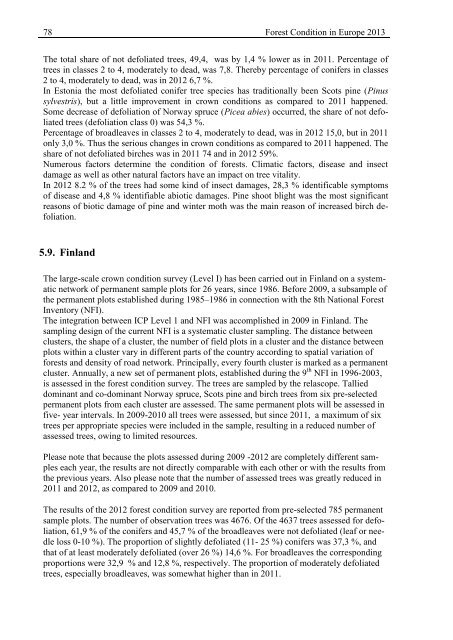Forest Condition in Europe - ICP Forests
Forest Condition in Europe - ICP Forests
Forest Condition in Europe - ICP Forests
You also want an ePaper? Increase the reach of your titles
YUMPU automatically turns print PDFs into web optimized ePapers that Google loves.
78 <strong>Forest</strong> <strong>Condition</strong> <strong>in</strong> <strong>Europe</strong> 2013<br />
The total share of not defoliated trees, 49,4, was by 1,4 % lower as <strong>in</strong> 2011. Percentage of<br />
trees <strong>in</strong> classes 2 to 4, moderately to dead, was 7,8. Thereby percentage of conifers <strong>in</strong> classes<br />
2 to 4, moderately to dead, was <strong>in</strong> 2012 6,7 %.<br />
In Estonia the most defoliated conifer tree species has traditionally been Scots p<strong>in</strong>e (P<strong>in</strong>us<br />
sylvestris), but a little improvement <strong>in</strong> crown conditions as compared to 2011 happened.<br />
Some decrease of defoliation of Norway spruce (Picea abies) occurred, the share of not defoliated<br />
trees (defoliation class 0) was 54,3 %.<br />
Percentage of broadleaves <strong>in</strong> classes 2 to 4, moderately to dead, was <strong>in</strong> 2012 15,0, but <strong>in</strong> 2011<br />
only 3,0 %. Thus the serious changes <strong>in</strong> crown conditions as compared to 2011 happened. The<br />
share of not defoliated birches was <strong>in</strong> 2011 74 and <strong>in</strong> 2012 59%.<br />
Numerous factors determ<strong>in</strong>e the condition of forests. Climatic factors, disease and <strong>in</strong>sect<br />
damage as well as other natural factors have an impact on tree vitality.<br />
In 2012 8.2 % of the trees had some k<strong>in</strong>d of <strong>in</strong>sect damages, 28,3 % identificable symptoms<br />
of disease and 4,8 % identifiable abiotic damages. P<strong>in</strong>e shoot blight was the most significant<br />
reasons of biotic damage of p<strong>in</strong>e and w<strong>in</strong>ter moth was the ma<strong>in</strong> reason of <strong>in</strong>creased birch defoliation.<br />
5.9. F<strong>in</strong>land<br />
The large-scale crown condition survey (Level I) has been carried out <strong>in</strong> F<strong>in</strong>land on a systematic<br />
network of permanent sample plots for 26 years, s<strong>in</strong>ce 1986. Before 2009, a subsample of<br />
the permanent plots established dur<strong>in</strong>g 1985–1986 <strong>in</strong> connection with the 8th National <strong>Forest</strong><br />
Inventory (NFI).<br />
The <strong>in</strong>tegration between <strong>ICP</strong> Level 1 and NFI was accomplished <strong>in</strong> 2009 <strong>in</strong> F<strong>in</strong>land. The<br />
sampl<strong>in</strong>g design of the current NFI is a systematic cluster sampl<strong>in</strong>g. The distance between<br />
clusters, the shape of a cluster, the number of field plots <strong>in</strong> a cluster and the distance between<br />
plots with<strong>in</strong> a cluster vary <strong>in</strong> different parts of the country accord<strong>in</strong>g to spatial variation of<br />
forests and density of road network. Pr<strong>in</strong>cipally, every fourth cluster is marked as a permanent<br />
cluster. Annually, a new set of permanent plots, established dur<strong>in</strong>g the 9 th NFI <strong>in</strong> 1996-2003,<br />
is assessed <strong>in</strong> the forest condition survey. The trees are sampled by the relascope. Tallied<br />
dom<strong>in</strong>ant and co-dom<strong>in</strong>ant Norway spruce, Scots p<strong>in</strong>e and birch trees from six pre-selected<br />
permanent plots from each cluster are assessed. The same permanent plots will be assessed <strong>in</strong><br />
five- year <strong>in</strong>tervals. In 2009-2010 all trees were assessed, but s<strong>in</strong>ce 2011, a maximum of six<br />
trees per appropriate species were <strong>in</strong>cluded <strong>in</strong> the sample, result<strong>in</strong>g <strong>in</strong> a reduced number of<br />
assessed trees, ow<strong>in</strong>g to limited resources.<br />
Please note that because the plots assessed dur<strong>in</strong>g 2009 -2012 are completely different samples<br />
each year, the results are not directly comparable with each other or with the results from<br />
the previous years. Also please note that the number of assessed trees was greatly reduced <strong>in</strong><br />
2011 and 2012, as compared to 2009 and 2010.<br />
The results of the 2012 forest condition survey are reported from pre-selected 785 permanent<br />
sample plots. The number of observation trees was 4676. Of the 4637 trees assessed for defoliation,<br />
61,9 % of the conifers and 45,7 % of the broadleaves were not defoliated (leaf or needle<br />
loss 0-10 %). The proportion of slightly defoliated (11- 25 %) conifers was 37,3 %, and<br />
that of at least moderately defoliated (over 26 %) 14,6 %. For broadleaves the correspond<strong>in</strong>g<br />
proportions were 32,9 % and 12,8 %, respectively. The proportion of moderately defoliated<br />
trees, especially broadleaves, was somewhat higher than <strong>in</strong> 2011.
















